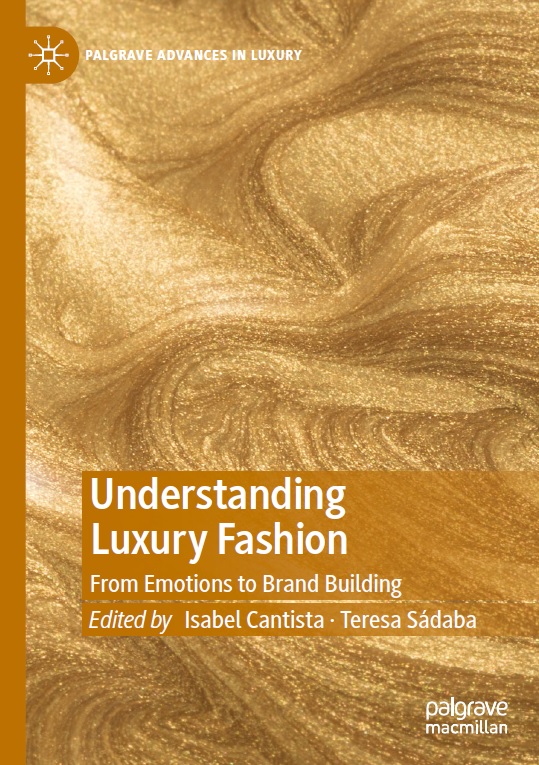
Contents
Part I Introduction
1 Understanding Luxury Fashion: Origins and Contemporary Issues 3
Isabel Cantista and Teresa Sádaba
2 Understanding Luxury: A Philosophical Perspective 13
Marta Mendonça
Part II Understanding Luxury and Emotions
3 From Mere Luxury to Unique Lifestyle:
The Transformation of Taste in the ‘Age of Glamour’ 31
Ambrogia Cereda
4 The Dark Side of Luxury: When Negative Emotions
Are Felt by Very Wealthy Consumers 63
Virginie De Barnier and Elyette Roux
5 Future Luxury: Fashioning Wellbeing Through
Holistic Design 89
Kirsten Scott
Part III Understanding Luxury and Society
6 Sustainable Luxury: The Effect of Corporate
Social Responsibility Strategy on Luxury
Consumption Motivations 123
Carmela Donato, Matteo De Angelis and Cesare Amatulli
7 Luxury Perfume Brands and Millenial Consumers 147
Aileen Stewart and Lindsey Carey
8 The Evolution of the Chinese Luxury Fashion Consumer:
An Interpretive Study of Luxury Value Perceptions 175
Patsy Perry, Liz Barnes and Tiantian Ye
Part IV Case Studies: Brand Building and Communication
9 Speedy Tuesday: Omega’s Adoption
of Communication 4.0 205
François H. Courvoisier and Claire Roederer
10 Brand Building: The Case of Collaboration
Between Javier Carvajal and Loewe 221
Eugenia Josa, María Villanueva and Isabel Cantista
11 Rapha: Weaving Story Strands of Luxury 243
Catherine Glover
Author Index 275
Subject Index 279
List of Figures
Fig. 5.2 Ugandan barkcloth 103
Fig. 5.3 Finished piece of Ugandan barkcloth 104
Fig. 5.4 Karen Spurgin dye experiments 106
Fig. 5.5 Karen Spurgin black dye sample 106
Fig. 5.6 Wild fig tree, bark harvested 108
Fig. 5.7 BOTFA barkcloth makers 109
Fig. 5.8 Proposition 1 110
Fig. 5.9 Proposition 2 112
Fig. 5.10 Indigo-dyed appliqué 113
Fig. 5.11 Crafting the cape 114
Fig. 6.1 Proposed moderation model 137
Fig. 6.2 Johnson-Neyman floodlight analysis for experimental data analysis 137
Fig. 8.1 Empirical framework of Chinese luxury fashion consumer value 197
Fig. 11.1 Image from Rapha.cc website, Men’s Shop section showing a ‘Classic Jersey II’ cycling jersey top (2017) (© Rapha—reproduced with permission) 249
Fig. 11.2 Image from Rapha.cc website, Men’s Shop section, showing ‘Premium Denim—Slim’ jeans (2017) (© Rapha—reproduced with permission) 251
Fig. 11.3 Image from Rapha.cc website, ‘Membership‘ page (2017) (© Rapha—reproduced with permission) 257
Fig. 11.4 Photograph of pillar displaying royal insignia and crown,
at the entrance to Regent’s Park, London (2017) 260
Fig. 11.5 Image of Rapha.cc website, ‘RCC Summit Boulder’
webpage (2017) (© Rapha—reproduced with permission) 261
Fig. 11.6 Citroën H-Van in Rapha’s Soho Clubhouse in Brewer
Street, London (2017) (© Rapha—photographed with permission) 264
Fig. 11.7 [left] Rapha Body Wash (2017) (© Rapha—reproduced with permission) 265
Fig. 11.8 Photograph of cyclist on Mont Ventoux, beside
packaging of Rapha Body Wash showing same landscape
(2017) (© Rapha—photographed with permission) 266
Fig. 11.9 A coffee on glass display table containing paper map
in Rapha’s Soho Clubhouse, London (2017)
(© Rapha—photographed with permission) 267
List of Tables
Table 4.1 Negative emotions evoked during luxury consumption—fear 69
Table 4.2 Fear evoked during luxury consumption specific to China 70
Table 4.3 Negative emotions evoked during luxury consumption—anger and sadness 72
Table 4.4 Guilt for luxury consumption 74
Table 4.5 The way to alleviate feelings of guilt 77
Table 4.6 Shame for luxury consumption and the way to justify it (specific to China) 79
Table 4.7 Sample characteristics for Brazil and China 82
Table 5.1 Holistic Design Methodology 98
Table 6.1 A multidimensional model of CSR 128
Table 6.2 Scenarios employed to manipulate type of CSR initiative 136
Table 7.1 Thematic representation of data 160
Table 8.1 Respondent profiles 189
Table 8.2 Interview topic guide 190
Table 8.3 Final thematic template 196
Foreword
Understanding Luxury Fashion: From Emotions to Brand Building is not an option in the contemporary world of fashion. It is a necessity due to the outstanding development of luxury products and services in the field of Fashion.
In this book, edited by Isabel Cantista and Teresa Sabada, both teaching at University, the luxury dimension in Fashion is explored through ten chapters, mixing theory and case studies, with an international approach.
What is particularly interesting is the choice made by the editors to highlight the preeminence of the immaterial perspective on material and tangible aspects. This immaterial dimension is key and deals with the “aspirational” needs related to personal values and the “positional” needs, which are more external and social.
This approach leads to a transdisciplinary framework, combining philosophy, psychology, sociology and history, enabling a comprehensive and deep analysis of the phenomenon of luxury fashion.
However, the current challenges are not ignored, when it comes to the impact of digital technologies and sustainability through the whole fashion value chain. The growing importance of China and Chinese consumers in luxury fashion, all over the world, is also underlined.
